Friday, January 15. 2010
Part of an extraordinary long quote from A Woman in Berlin in a piece at Never Yet Melted:
...I long ago lost my childhood piety, so that God and the Beyond have become mere symbols and abstractions. Should I believe in progress? Yes, to biggger and better bombs. The happiness of the greater number? Yes, for Petka and his ilk. An idyll in a quiet corner? Sure, for people who comb the fringes of their rugs. Possessions, contentment?
I have to keep from laughing, homeless urban nomad that I am. Love? Lies trampled on the ground. And were it ever to rise again I would always be anxious, could never find true refuge, would never again dare hope for permanence.
Perhaps art, toiling away in the service of form? Yes, for those who have the calling, but I don’t. I’m just an ordinary laborer, I have to be satisfied with that. All I can do is touch my small circle and be a good friend. What’s left is just to wait for the end. Still the dark and amazing adventure of life is beckoning. I’ll stick around, out of curiosity and because I enjoy breathing and stretching my healthy limbs.
Wednesday, January 13. 2010
Identify the perpetrators of atrocities upon children as sociopaths or whatever (see Dr. Joy Bliss' post below), and the words don't come near the horrors they commit, which are monstrous, whether during the Holocaust or today in many countries.
Here's a photo from a group of 41 children, ages 3-13, plus ten adult staff the Nazis tore from their refuge near Lyon, France on April 6, 1944. The children were sent to Auschwitz and murdered, as were the staff.
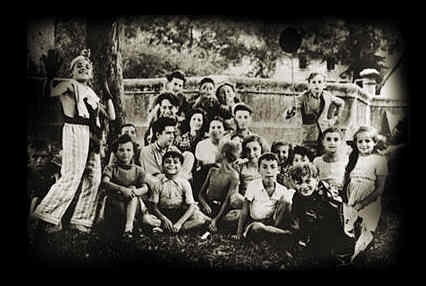
Up to 1.5-million children were murdered in the death camps, about 1.2-million of them Jews, the others Roma or handicapped.
Holocaust by Barbara Sonek
We played, we laughed
we were loved.
We were ripped from the arms of our parents
and thrown into the fire.
We were nothing more than children.
We had a future.
We were going to be lawyers, rabbis, wives, teachers, mothers.
We had dreams, then we had no hope.
We were taken away in the dead of night
like cattle in cars, no air to breathe
smothering, crying, starving, dying.
Separated from the world
to be no more.
From the ashes, hear our plea
This atrocity to mankind can not happen again.
Remember us, for we were the children
whose dreams and lives were stolen away.
Here's a photo of a few of the very few children who survived to liberation.
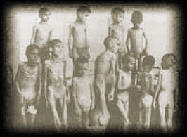
We see similar photos today of children elsewhere in the world who suffer. Remember and do more than repeat the mantra "Never Again."
More info about the once happy children in the first photo at this site.
HT: My good friend "Charlite", a righteous Gentile.
Thursday, January 7. 2010
Jacob Burkhardt did. First Principles.
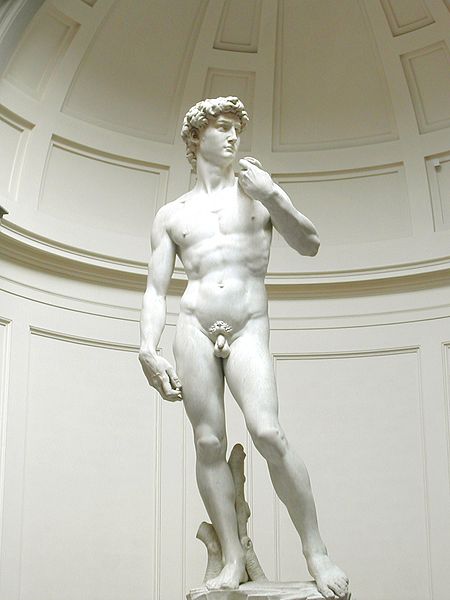
Monday, December 28. 2009
Monday, December 21. 2009
Thursday, December 17. 2009
Tuesday, December 8. 2009
Two approaches to transitioning economies, by Gregory and Zhou at Hoover's Policy Review
Saturday, December 5. 2009
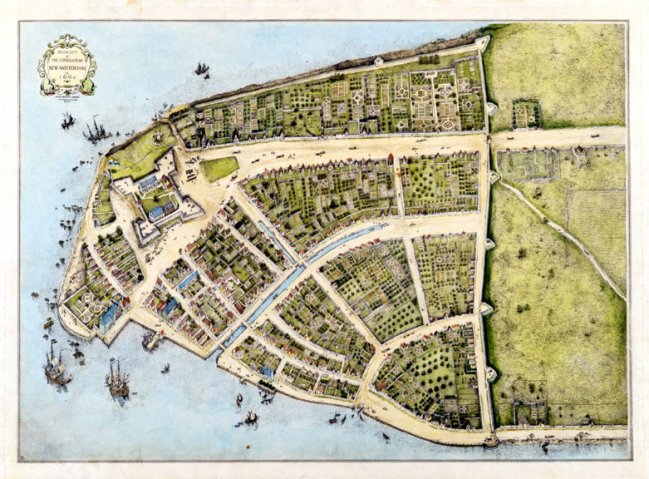
The Island at the Center of the World: The Epic Story of Dutch Manhattan and the Forgotten Colony that Shaped America, by Russell Shorto (2005).
A wonderful story. The Dutch colony of New Amsterdam, owned and run by the Dutch West India Company, was a quickly growing and boisterous commercial settlement of over 200 when the Pilgrims landed in Massachusetts. When the Dutch sent a friendly delegation up to Plymouth in 1624 or so with goodies and gifts of sugar, William Bradford sent a letter back with the delegation saying that he was sorry that he had nothing desirable to offer to return the favor.
On quote from the book re the Wickquasgeck Trail:
Broadway does not follow the precise course of the Indian trail, as some histories would have it. To follow the Wickquasgeck Trail today, one would take Broadway north from the Customs House, jog eastward along Park Row, then following the Bowery to 23rd St. From there, the trail snaked up the east side of the island. It crossed westward through the top of Central Park; the paths of Broadway and the Wickquasgeck Trail converge again at the top of the island. The trail continued into the Bronx: Route 9 follows it northward.
The Customs House was the site of the original Dutch fort to protect them from the Indians. The Lenape Indians turned out to be friendly to the Dutch (believing them to be potential allies against other tribes), so the fort was never well-maintained. Hence the Brits had no problem taking the town in 1664.
Today the Customs House is the home of the Museum of the American Indian. Worth a visit.
Related, years ago I read Beverly Swerling's City of Dreams: A Novel of Nieuw Amsterdam and Early Manhattan, which does a great job evoking the times - and the medical care of the times. Many would argue, I think, that NYC remains more of a Dutch heritage city than an English one.
Image: New Amsterdam, c. 1660
Saturday, November 14. 2009
 An uplifting piece about freedom at American Thinker. An uplifting piece about freedom at American Thinker.
Even freedom of food is easy to lose and difficult to regain.
Lots of folks around the world like to eat McD's when they are hungry. I do not care for it much (I like Subway for on-the-road fast food if there is no local seafood or redneck joint in view), but what does what I like have to do with anything - except me?
I do not give a darn what other people eat. Food has become a fetish for some people. (For the French and the Italians, I will make excuses, however.)
Monday, November 9. 2009
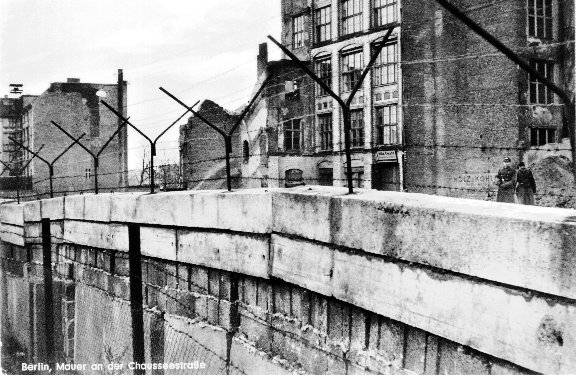
Walker at Am Thinker begins:
Twenty years ago today an
architectural monument to human enslavement melted before the eyes of
the world: The Wall, the horrific complex of barbed wire, mine fields,
police dogs, killing zones, and constant military guards was torn down
by East Germans who finally saw a chance for liberty.
There was always something surreal about the Wall.
Funny how Leftist utopias always require walls, thought police, machine guns and barbed wire. And thuggish dictators in control of everything. Read the whole thing.
Photo from this site.
Sunday, October 18. 2009
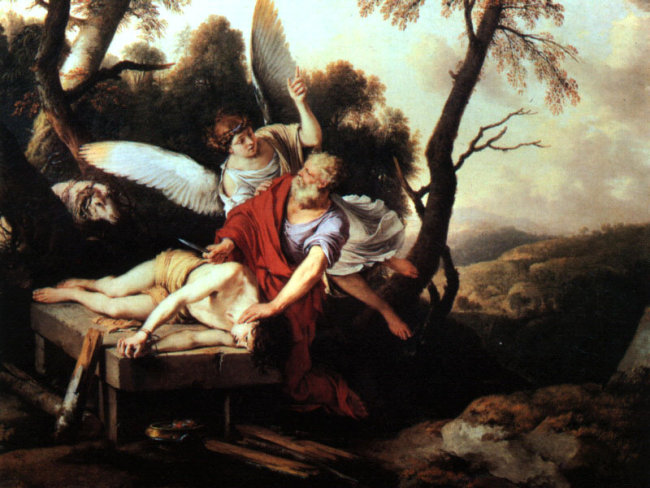
From scholar Richard Rubenstein's The Religion of Sacrifice and Abraham, Isaac and Jesus:
Judaism never entirely rejected the idea that God demands the sacrifice of the first-born son. However we evaluate the existence of child sacrifice in ancient Judah, Israel, Canaan, and the colonies of Canaan-Phoenicia, it is evident that we are dealing with a God who demands the death of children. In reflecting on the issue of child sacrifice in Judaism and Christianity, Levenson comments, “…the mythic-ritual complex that I have been calling ‘child sacrifice’ was never eradicated; it was only transformed."
A prime example of that transformation is the pidyon ha-ben ritual in fulfillment of the commandment already noted: “You shall redeem all the firstborn of your sons. None shall appear before Me empty-handed.” (Exodus 34:20) In this ceremony, the father presents his first-born son to a cohen or hereditary priest on the thirtieth day after his birth whereupon the priest asks the father, "Which do you prefer, your son or your money?" The father declares that he prefers his son and presents the cohen with five silver dollars, the symbolic equivalent of five biblical shekels, in order to "redeem" his son. The priest accepts the coins with the ritual formula, "This (the coins) in place of that (the child). This in exchange for that."
 Read the whole thing. We Christians often refer to Christ as "the lamb of God;" "Lamb" because a "spotless lamb" was one of the ritual Jewish sacrifices of the time, used as a symbolic substitute for human sacrifice like Abraham's ram in the thicket. Read the whole thing. We Christians often refer to Christ as "the lamb of God;" "Lamb" because a "spotless lamb" was one of the ritual Jewish sacrifices of the time, used as a symbolic substitute for human sacrifice like Abraham's ram in the thicket.
Christians view the sacrifice of Christ - God's "son" - as the final and essential sacrifice needed to redeem a fallen mankind. Thus the ancient themes of blood and human sacrifice endure and give deadly serious substance to our worship today.
My August photo of the stone urns in Carthage which contained the ashes of firstborns sacrificed to Baal:
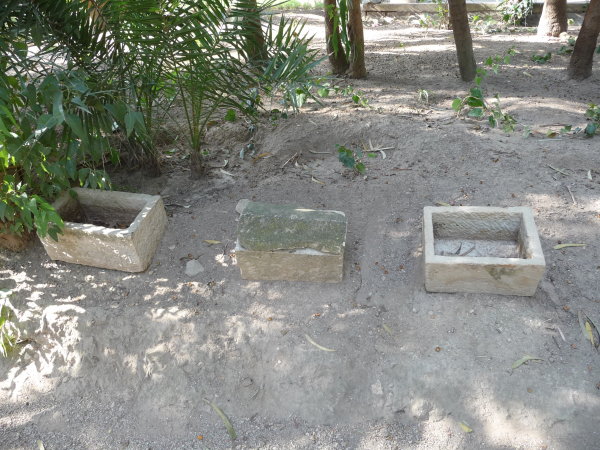
Saturday, October 17. 2009

You may have seen these photos of Hitler and the Nazi era when first published by LIFE.com, but I missed them.
I think seeing these photos in color makes them more ominously ordinary - the banality of evil and all that. In other ways, they look more like a WW2 movie. What's your view?
Here's the story of the photos, from LIFE:
Between 1936 and 1943, German photographer Hugo Jaeger was granted unprecedented access to Adolf Hitler, traveling and chronicling, in color, the Fuhrer and his confidants at small gatherings, public events, and, quite often, in private moments. Here, and in several other galleries on LIFE, we present never-before-published photographs from Jaeger's astonishing -- and chilling -- collection.
... in 1945, when the Allies were making their final push toward Munich, Jaeger found himself face to face with six American soldiers in a small town west of the city. During a search of the house where Jaeger was staying, the Americans found the leather suitcase in which Jaeger had hidden thousands of his color negatives. He knew he would be arrested (or worse) if the Americans discovered his film and his close connection to Hitler. But what happened next astonished him.
Inside the suitcase that held the Hitler images, Jaeger had also placed a bottle of cognac. Happy with their find, the soldiers proceeded to shared the bottle with Jaeger and the owner of the house. The suitcase was forgotten.
After the Americans left, Jaeger packed the slides into 12 glass jars and buried them on the outskirts of town. In the years following the war, Jaeger occasionally returned to his multiple caches, digging them up, repacking, and reburying them. He finally retrieved the colllection for good--2,000 transparencies, all of them, amazingly, still in good shape -- and in 1965 sold them to LIFE.
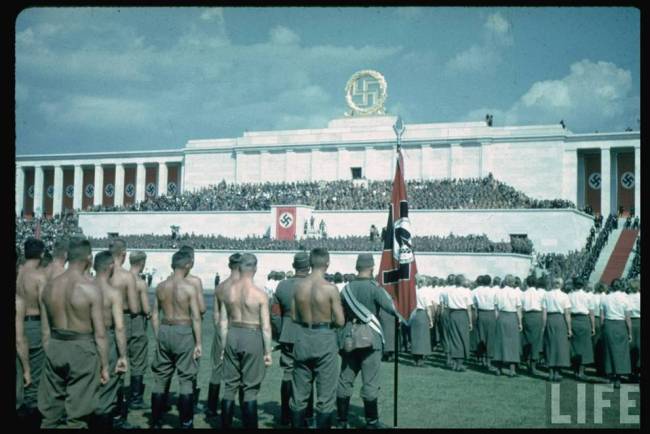
Many of the photos can be seen at LIFE.com.
We have a few more below the fold - more of LIFE's stash can be found at various places online.
Continue reading "Hitler in color"
Saturday, October 10. 2009
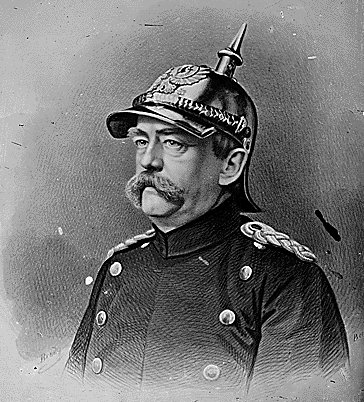 The WSJ notes: The WSJ notes:
Germany's health-care system was brought to life in 1883 by Otto von Bismarck and became the model for virtually every such state-directed national insurance plan since. Alas, the German system is starting to come apart at the financial seams. Germany's system relies on a handful of state-supported health insurers. This week they informed the government that the system was on the brink of a financial shortfall equal to nearly $11 billion.
Read the whole thing about how it all went wrong.
This site reminds us of Bismarck's role in the creation of the modern Fascist-Welfare state.
Tuesday, October 6. 2009
With a video too. Giant docks, warehouses, and a man-made harbor. (h/t, Jungleman)
Sunday, October 4. 2009
At First Principles. Just one quote:
The British, seeking to adapt to the aspirations of a modern, democratizing age, weaned themselves from Magna Carta. The Americans, “born equal, instead of becoming so,” in Tocqueville’s phrase, found in Magna Carta a symbol of political liberty, silently ignoring its feudal excrescences and adopting the common law insofar as it was, in the later words of Joseph Story, “applicable to the situation of the colony, and . . . not . . . altered, repealed, or modified by any of our subsequent legislation.” The Americans eventually established many of the Charter’s provisions in written constitutions of their own.
Wednesday, September 30. 2009
 That's King Buck on the 1959 Federal Duck Stamp. A great champion, and the prize of avid sportsman John Olin's Nilo Kennels. That's King Buck on the 1959 Federal Duck Stamp. A great champion, and the prize of avid sportsman John Olin's Nilo Kennels.
In 1931 the Olin chemical and ammo company bought the bankrupt Winchester Repeating Arms company, and still owns the trademark for the firearms and makes the ammo.
The story of Winchester is the sad story of manufacturing and unions in the Northeast. From the Wiki:
By the 60's the cost of skilled labor was making it increasingly difficult profitably to produce Winchester's classic designs, incorporating as they did considerable hand-work. In particular, Winchester's flagship Model 12 pump shotgun and Model 70 bolt-action rifle with their machined forgings could no longer compete in price with Remington's cast-and-stamped 870 and 721. Accordingly S. K. Janson formed a new Winchester design group to advance the use of "modern" engineering design methods and manufacturing principles in gun design. The result was a new line of guns which replaced most of the older products in 1963-64. Unfortunately the reaction of the shooting press and public was overwhelmingly negative: the popular verdict was that Winchester had sacrificed quality to the "cheapness experts,"[1] and market share continued to decline as Winchester was no longer considered to be a prestige brand. Gun collectors consider "post-64" Winchesters to be both less desirable and less valuable than their predecessors.
Labor costs continued to rise, and a prolonged and bitter strike in 1979-80 convinced Olin that firearms could no longer be produced profitably in New Haven. Therefore in December 1980 the plant was sold to its employees, incorporated as the U.S. Repeating Arms Company, together with a licence to make Winchester arms. Olin retained the Winchester ammunition business.
From 1981 until 2006, Winchester guns were made by the U.S. Repeating Arms Company. When U.S. Repeating Arms went bankrupt in 1989 it was acquired by a French holding company, then sold to an arms making cartel sponsored by the Belgian Herstal Group, which also owns gun makers Fabrique National (FN) and Browning.
On January 16, 2006 U.S. Repeating Arms announced it was closing the New Haven, Connecticut, plant where Winchester rifles and shotguns were produced for 140 years.[1] Along with the closing of the plant, the Model 94 rifle (the descendant of the original Winchester rifle), Model 70 rifle and Model 1300 shotgun would be discontinued.
On August 15, 2006, Olin Corporation, owner of the Winchester trademarks, announced that it had entered into a new license agreement with Browning to make Winchester brand rifles and shotguns, though not at the closed Winchester plant in New Haven. Browning, based in Morgan, Utah, and the former licensee, U.S. Repeating Arms Company, are both subsidiaries of FN Herstal. In 2008 FN Herstal announced that it would produce Model 70 rifles at its plant in Columbia, SC.
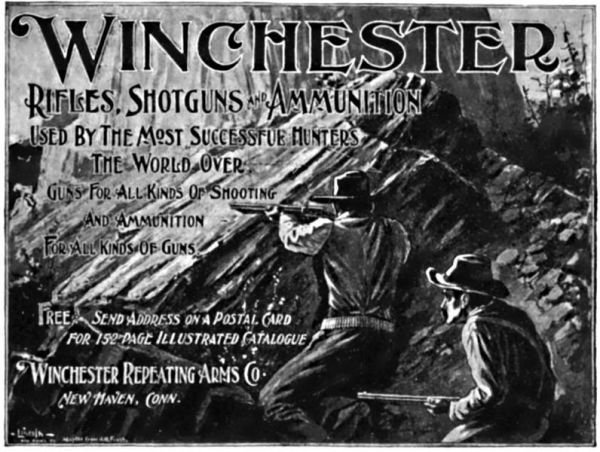
It's interesting to read the histories of companies. Here's the history of the Olin Corp, which still makes Winchester ammo. I had the pleasure of meeting some good folks from the company recently.
Thursday, September 24. 2009
Huge treasure trove of 1400 year-old Anglo-Saxon gold found in Staffordshire. Looks like things a king would have owned.
h/t, Synthstuff

Tuesday, September 22. 2009
Prehistoric sat-nav in England.
Gwynnie tells me that our western Indians did the same with petroglyphs, but I do not have the links.
Amost everybody likes to go places without getting lost. I got lost in Barcelona, but it's not like really being lost when there's a cafe and tapas joint nearby.
Monday, September 14. 2009
Managed to find my way to the delightful town of Lucca two weeks ago, the home of the beloved Jack Puccini and his illustrious musical ancestors. More than a tunesmith - but what a tunesmith. Here's his family church in which he first performed:
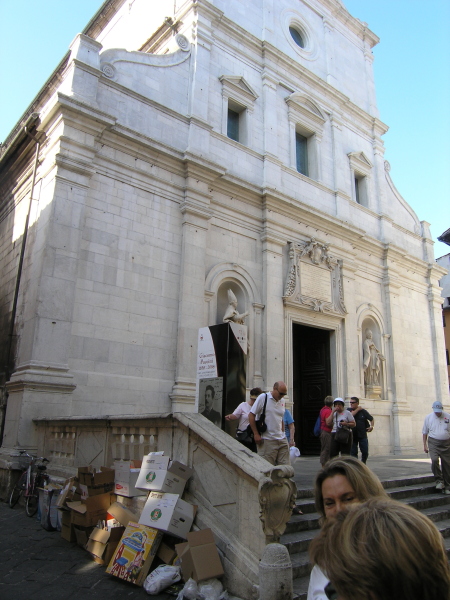
and here's the house he grew up in (second one in from the right corner):
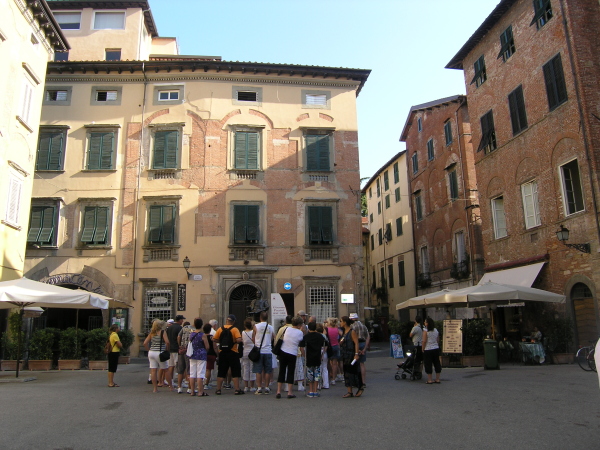
More Lucca photos later...plus lunch, of course.
Saturday, September 12. 2009
Why did we schlepp all the way down to Agrigento last week? To see the Valley of the Temples (and to get a good lunch).
Why they call it "valley" I do not know, because this assembly of Doric Greek temples were built along a ridge - an acropolis, as always - within view of the busy harbor. It must have been quite a sight.
These were built before the Parthenon, around 460 BC - by Carthaginian slaves. The Temple of Zeus was five times the size of the Parthenon. The old Greek-era town was large (200,000 in 500 BC) and prosperous. Empedocles (the four elements, etc) lived there.
Most of the temples are in ruins either from earthquakes or use of the stones for other building purposes. The so-called Temple of Concord is in good shape, and was in use as a Christian church until the 1700s:
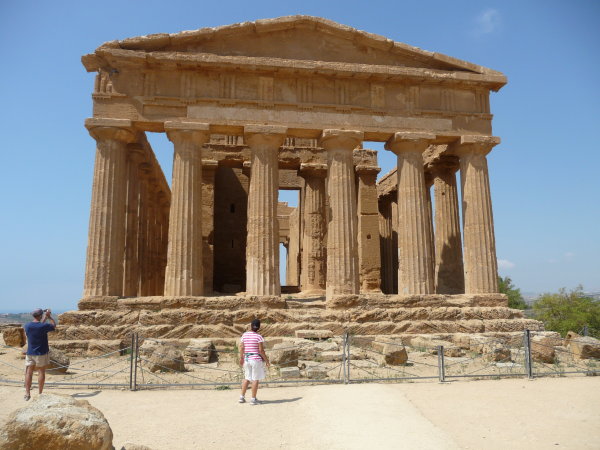
That's limestone. No marble around. You cannot really make good sculptures with limestone. To make the temples white, they were covered with a layer of plaster - some of which remains. The proscenia were painted bright colors, as the Greeks always did.
More about Agrigento, and lunch, below:
Continue reading "My summer trip: Agrigento, with almond groves and a fine lunch at Baglio della Luna"
Friday, September 11. 2009
Somewhere around 450 AD (according to the Venerable Bede), the Celtic warlord Vortigern, embattled by the northern Picts, made a decision that would change the world: He invited the Frisian brothers Horsa and Hengest to bring their warriors across the sea as mercenaries and help him defeat the Picts. After the fierce northern Germanic warriors ensured Vortigern’s victory, he tried to cheat them out of their payment, and they responded by founding a kingdom in southern England. Thus began the Anglo-Saxon migration, and soon, conquest.
The world went crazy after the fall of Rome. Read the rest. It's about the Olde.Anglosphere. As far as I know, basic English is still Frisian (except for the added Viking, Frenchy, Greek and Latinate stuff).
The historic Battle of Teutoberg Forest.
It stopped the Romans in the same way that Lepanto stopped the Moslems.
Wednesday, September 9. 2009
Most of Roman Carthage (which was the third largest Roman metropolis in the 200-400 era, after Rome and Alexandria - the population was around 300,000) is buried beneath the modern town of Carthage, but some that is accessible has been excavated.
After the Third Punic War in 146 BC, very little remained of the old Phoenician Carthage - except things like these boxes. The Phoenicians worshipped Baal, who required that everybody's first-born be sacrificed. The ashes of these kids were buried in these sad little stone boxes.

More of my photos of cool Roman Carthage ruins below -
Continue reading "My summer vacation: Carthage"
Wednesday, September 2. 2009
A re-post -
 In a comment on our piece about clear-cutting, a reader let us know about this book: 1491: New Revelations about the Americas Before Columbus, by Charles Mann. In a comment on our piece about clear-cutting, a reader let us know about this book: 1491: New Revelations about the Americas Before Columbus, by Charles Mann.
Human fantasies about the Garden of Eden, like human utopian fantasies, just never give up. You might almost think we all wish we were back in the womb.
I ordered the book, but here's a quote from Charles Mann's 2002 essay in The Atlantic on the subject:
Before it became the New World, the Western Hemisphere was vastly more populous and sophisticated than has been thought—an altogether more salubrious place to live at the time than, say, Europe. New evidence of both the extent of the population and its agricultural advancement leads to a remarkable conjecture: the Amazon rain forest may be largely a human artifact.
It's a fascinating subject to me. Here's the whole essay.
Image: An early version of Edward Hicks' Peaceable Kingdom
|




 Magnifico: The Brilliant Life and Violent Times of Lorenzo de' Medici
Magnifico: The Brilliant Life and Violent Times of Lorenzo de' Medici

 An uplifting piece about freedom
An uplifting piece about freedom 

 Read the
Read the 


 The WSJ notes:
The WSJ notes: That's
That's 

 In a comment on
In a comment on